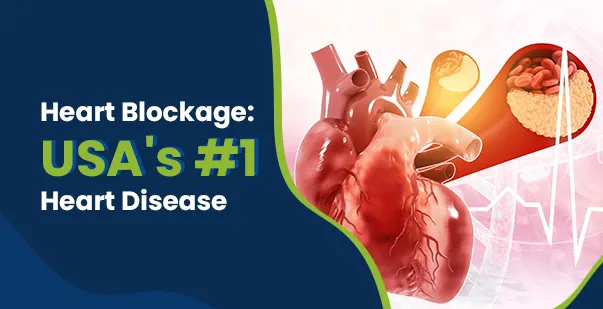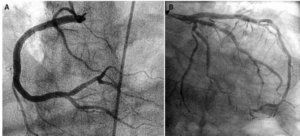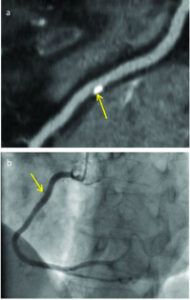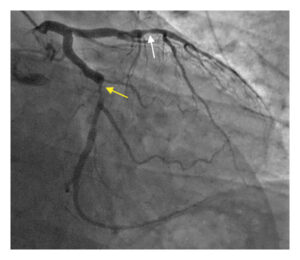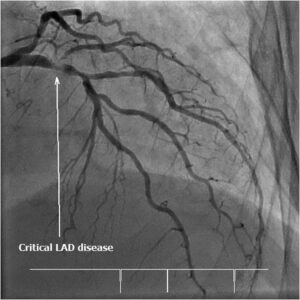Table of Contents:
- Introduction
- How Heart Blockage Occurs
- Types of Heart Blockage
- Warning Signs When An Artery Is Blocked
- How Is Coronary Artery Disease Treated?
- Adopt Heart Blockage Prevention Strategies Backed by Experts!
Introduction
A heart blockage, also known as blocked arteries or coronary artery disease, is a disorder in which blood flow through one or more of the three main coronary arteries is either partially or fully disrupted. With longer life expectancy and age playing a major role in coronary artery disease (CAD), most patients with acute coronary syndromes (ACS) are now over 65.
Cardiovascular disease appears 7 to 10 years later in women than in men. However, women are at higher risk beyond the age of 65. In this guide, let’s discuss the progression of heart blockage with pictures and how much artery blockage is normal.
How Heart Blockage Occurs
Coronary artery disease or heart blockage occurs when the coronary arteries, which provide blood to the heart, become narrow. This narrowing occurs due to the buildup of cholesterol and other substances that form plaque on the inner walls of coronary arteries. Thus, there will be limited blood flow to the heart, which may lead to chest pain or sometimes heart attack.
To understand more in-depth, let’s examine the anatomy of the human heart, which is lined with coronary arteries, and compare the various percentages of coronary artery blockages.
Coronary Arteries
According to the given diagram, the heart receives blood from three arteries that run across its surface. The right side of the heart has one artery, while the left side of the heart has two. The artery on the right side of the heart is referred to as the right coronary artery.
The arteries present on the left side are known as left coronary arteries, which consist of branches, such as the left anterior descending (LAD) artery and OM2 (obtuse marginal) or left circumflex artery. LAD artery is referred to as a “widowmaker” because a blockage here can prevent blood flow to a wide section of the heart and cause serious heart attacks if not addressed quickly.
OM2 serves the blood to the sidewall, while the LAD runs along the front of the heart and supplies the front and main walls of the heart. Significant LAD and OM2 artery blockages may lead to severe heart blockages.
Types of Heart Blockage
There are four types of heart blockages. The most common type of heart blockage is a severely narrowed or blocked blood artery associated with the condition. However, there may be mild blockage that can significantly lead to severe blockages in the arteries. Thus, it is important to learn about the categories that might range from mild to severe based on heart blockage percentage.
-
Mild Coronary Artery Disease
The diagram above depicts an artery with obstructions ranging from 20% to 40%. Heart obstructions of less than 40% are typically classified as minor. Such blockages generally do not hinder blood flow and are unlikely to cause symptoms.
However, it is important to note that there is clear evidence of increasing coronary artery disease in these patients. They require strong attention to cardiovascular disease risk factors, including blood pressure, smoking, diabetes, and cholesterol.
-
Moderate Coronary Artery Disease
A moderate level of cardiac blockage is often between 40-70%. The diagram above depicts a 50% blockage at the starting point of the right coronary artery. In most cases, moderate heart blockage does not significantly restrict blood flow and, therefore, does not cause symptoms. Similar to mild coronary artery disease, moderate coronary artery disease is managed with medication and healthy lifestyle changes.
Heart blockage at the upper end of the moderate range (50%–70%) may require additional testing to evaluate 70 percent of heart blockage symptoms and determine whether the condition is severe.
-
Severe Coronary Artery Disease
Severe cardiac blockage is often greater than 70%. This degree of narrowing is associated with significantly reduced blood flow to the heart muscle, which can cause symptoms such as chest discomfort and shortness of breath. The diagram above depicts an 80 percent heart blockage at the starting point of the vessel. The severe heart blockage caused symptoms, which were treated with the placement of a stent, as shown in the image.
In some cases, bypass surgery is necessary due to multiple severe blockages.
-
Completely Occluded Artery (Major Heart Attack)
A complete occlusion involves more than 90 percent blockage in the heart at the starting point of the right coronary artery, as shown in the image above. This prevents blood flow and, as a result, causes a heart attack. Complete occlusion or 90 blockage in the heart is usually accompanied by severe symptoms such as chest discomfort and shortness of breath, requiring immediate treatment. This artery was treated with a stent, as shown in the image, to restore normal blood flow.
If left untreated (typically within the first few hours), the heart muscle may die. Once dead, it is unlikely to recover, leading to diminished heart pumping function and heart failure.
Warning Signs When An Artery Is Blocked
You may not experience symptoms during the initial stages of heart blockage. However, as plaque builds up and reaches a percentage of 80 blockage in the heart, it reduces blood supply to the heart muscle. This can lead to shortness of breath or fatigue, particularly during exercise.
Angina, also known as chest pain, is the most prevalent symptom of 90 blockage in the heart. Some individuals may mistake it for indigestion or heartburn. Along with chest pain, you might also feel pain in your jaw, shoulders, arms, or back. Symptoms may include:
- Tightness
- Discomfort
- Pressure
- Heaviness
- Squeezing
- Burning
- Aching
- Numbness
- Fullness
People with heart block may also have an increased likelihood of developing additional arrhythmias, such as atrial fibrillation, and may face a higher risk of a heart attack.
Read More: What Is a Normal Heart Rate? Everything You Need to Know
How Is Coronary Artery Disease Treated?
Treatment for coronary artery disease (CAD), with at least 75 blockages in the heart, often includes lifestyle changes, risk factor management, and medications. Some individuals may also require procedures or surgery.
Your healthcare provider will discuss the most suitable treatment plan for you. Follow your treatment plan to lower your risk of significant CAD complications.
Lifestyle changes
Lifestyle adjustments can help treat coronary artery disease. These modifications may include quitting smoking, vaping, or using tobacco products. Eat heart-healthy foods that are low in sodium, saturated fat, trans fat, and sugar. The Mediterranean diet has been shown to reduce the risk of heart attack and stroke. Also, try to get in 30 minutes of walking or other physical activity five days a week while limiting your alcohol intake.
Consult your healthcare practitioner before beginning a new exercise program. Your provider can also offer advice on lifestyle adjustments that are specific to your needs.
Risk Factor Management
Managing your CAD risk factors can assist in reducing the disease’s progression. Communicate with your provider to address the conditions, such as diabetes, high blood pressure, high cholesterol, hypertriglyceridemia, or sometimes having a BMI higher than 25.
Medications
You can control your risk factors and treat coronary artery disease symptoms with the use of medications. Your physician may give one or more drugs that lower your risk of blood clots, high blood pressure, and cholesterol. You can also manage stable angina using medications such as nitroglycerin and ranolazine.
Procedures and surgeries
Some individuals need procedures for coronary artery disease, like Percutaneous coronary intervention (PCI) and Coronary artery bypass grafting (CABG). PCI, also called coronary angioplasty, is a minimally invasive treatment. Your doctor will unblock your artery to enhance blood flow and may place a stent to keep it open.
CABG is a procedure that opens up a new blood vessel to bypass blockages. This “detour” improves blood flow to the heart. CABG helps individuals with significant blockages in multiple coronary arteries.
Read More: Activities to Promote Heart Health: Stay Active & Healthy
Adopt Heart Blockage Prevention Strategies Backed by Experts!
Heart blockage is the most prevalent type of heart disease in the United States. Coronary artery disease can cause major complications, such as heart attack and arrhythmia. However, an early and effective response may help you to prevent this serious complication. Taking Advanced Cardiac Life Support (ACLS), which is a collection of life-saving techniques and abilities, may help in cardiac emergencies, including myocardial infarction, stroke, and cardiac arrest. Monitor your heart health on a regular basis and prevent the heart blockage from becoming severe.
References:
- https://www.pennmedicine.org/for-patients-and-visitors/patient-information/conditions-treated-a-to-z/coronary-artery-disease
- https://www.cdc.gov/heart-disease/about/coronary-artery-disease.html
- https://www.webmd.com/heart-disease/coronary-artery-disease
- https://medlineplus.gov/coronaryarterydisease.html
- https://myheart.net/articles/heart-blockage-explained-with-pictures/
- https://www.medicalnewstoday.com/articles/180986#definition
- https://www.cedars-sinai.org/health-library/diseases-and-conditions/h/heart-block.html
- https://www.healthline.com/health/heart-disease/what-is-a-heart-block#bottom-line
- https://my.clevelandclinic.org/health/diseases/16898-coronary-artery-disease
